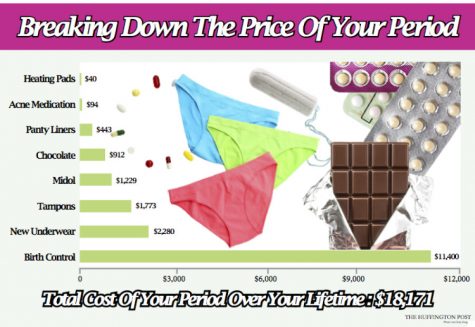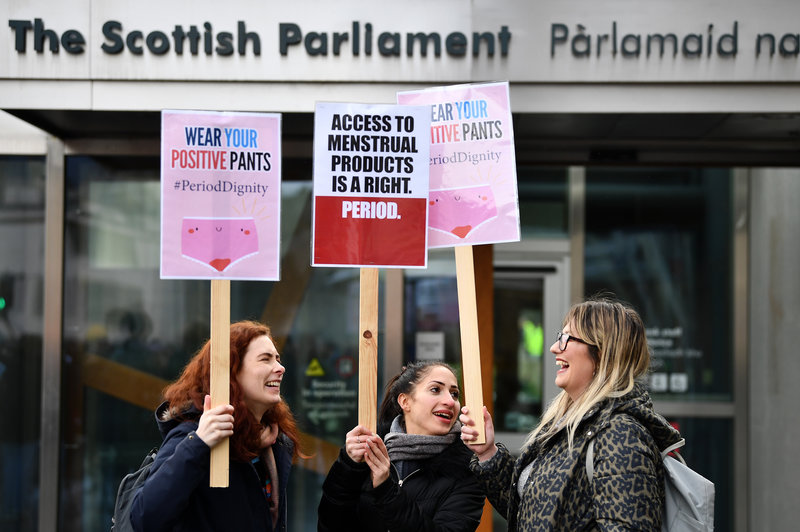The Problem with Periods
Menstrual products across America should be free for all women to access.
image courtesy of Getty Images
Activists rally in front of the Scottish Parliament in Edinburgh earlier this year in support of the Period Products Bill.
December 2, 2020
Imagine this: you go to the restroom in class one day and what you see on your underwear makes your eyes boggle. There’s a red stain. Not only have you begun your period, but you’ve bled through your underwear and the stain is now showing on your pants.
You rifle through your backpack to check for a pad or tampon but are dismayed to find neither. Taking out a piece of toilet paper and carefully fashioning it into a makeshift liner, you uncomfortably walk back to class. It’s hard to focus for the rest of the school day. You’re worried that others can see the reddish-brown tint on your pants—all because you didn’t have access to a tampon, pad, or menstrual cup.
Unfortunately, this is a scenario many women and girls have found themselves facing at one time or another.
Feminine hygiene products are costly and taxed in 33 states across America.
This tax on feminine hygiene products in the U.S. is roughly ten percent. The average box of 36 tampons is $7 on Amazon, but the additional $.70 in tax can add up over time. According to The Huffington Post, the average woman spends around $1,700 on tampons, pads, and menstrual cups in her lifetime.
Yet consider that products that treat male issues, such as Viagra, which treats erectile dysfunction, or Rogaine, which treats hair loss in men, are not taxed. That’s outright unfair. The average woman gets her period at the age of 12, whereas 25% of men begin to go bald when they hit the age of 30. Women can be taxed before they’re teenagers, but men don’t have to worry about it at all.
What’s even more inequitable is the fact that a woman spends over $18,000 on her period during her lifetime.

To put that amount in perspective, when my parents went to college, their tuition was around $6,000 each year. The cost of a woman’s period over her life was equivalent to a little over three years of college tuition in the early 90s. Some women don’t have the financial means to afford the cost of college, and losing nearly $20,000 to period products doesn’t help.
The mere fact that period products are costly and taxed (as a luxury item, by the way) necessitates immediate change.
Last Wednesday, a historic ruling was made by the Scottish Parliament that declared period products free to women across the country. The “Period Products Bill” passed unanimously and guarantees that “schools and colleges must ensure period products are freely available to students.”
According to an article by NPR, one in four women in Scotland struggled to have access to period products before the bill was passed. A tweet from the country’s official account stated that in Scotland “it’s fundamental to dignity, equality, and human rights” to have free access to period products.
The UK is the first country in the world to take such action. It’s long overdue for the rest of world to follow the same course.
Menstruation is more than a natural bodily function. A regular period is an indication of a healthy weight, among other things. As Dr. Nicky Keay stated recently in an interview with Women’s Health Magazine, “Your period is an excellent barometer of your health.”
Having access to feminine hygiene products shouldn’t be a privilege for those who can afford it. It’s a human right. Period.













Michelle Hwang • Dec 2, 2020 at 12:24 pm
Yes ma’am!!!! Such an important article Claire. Love it!